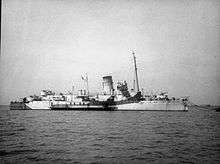PS Caledonia (1934)
 Caledonia departing Dunoon in 1967 | |
| History | |
|---|---|
| United Kingdom | |
| Name: |
|
| Operator: | Caledonian Steam Packet Company |
| Builder: | William Denny and Brothers, Dumbarton[1] |
| Yard number: | 1266 |
| Launched: | 1 Feb 1934 |
| Homeport: | Glasgow |
| Fate: | July 1980 Scrapped |
| General characteristics | |
| Class and type: | Paddle steamer |
| Tonnage: |
623 GRT; 161 tons deadweight (DWT); 274 NT |
| Length: | 70.1 m (230 ft 0 in) |
| Beam: | 18.9 m (62 ft 0 in) |
| Draft: | 2.3 m (7 ft 7 in) |
| Installed power: | Horizontal steam triple expansion 3cyl 1800 ihp |
| Speed: | 14 kn (service); 17 kn (max) |
PS Caledonia was a paddle steamer built in 1934. She principally provided an Upper Clyde ferry service, later moving to Ayr and then Craigendoran. Her final days were as a floating pub in London until destroyed by fire in 1980.
History
PS Caledonia was built by William Denny and Brothers of Dumbarton for the Caledonian Steam Packet Company. She was launched on Thursday 1 February 1934 and completed later that year.
Layout
Built to look more like a screw turbine than a traditional paddle steamer, Caledonia and her sister Mercury had plating carried around the sponsons. They had spacious promenade deck saloons fore and aft, with observation decks above each, linked and extended forward of the forward saloon. The navigation bridge was raised above the observation deck, forward of the single large elliptical funnel.
William Denny triple expansion three-crank engines gave a maximum speed of just over 17 knots.[2] In 1954 she was converted to oil fuel.
Service
Caledonia had a regular ferry programme connecting Gourock and Wemyss Bay with Dunoon and Rothesay. She also provided cruises to the Kyles of Bute and short cruises from Largs and Millport.[2]

In 1939 she was converted to a minesweeper and renamed HMS Goatfell. Her wartime service continued after 1941 as an anti aircraft ship.
In 1946 Caledonia was returned to her owners, but in 1954 the car ferry revolution displaced her to Ayr as excursion steamer, with relief sailings from Ardrossan to Arran. In 1965 she moved up-river to Craigendoran, to replace the withdrawn Jeanie Deans, cruising round Bute for a further five years, until the disastrous economics of Clyde cruising signalled the end.
In 1969 she was retired from service and sold for scrap. Saved by subsequent sale to Bass-Charrington, she served as a floating pub and restaurant named Old Caledonia on the Victoria Embankment of the River Thames. Badly damaged by fire in 1980, she was beyond economic repair and was scrapped in July 1980 at Milton Creek on The Swale near Sittingbourne, Kent. Her place in London was later taken by stable mate TS Queen Mary, until 2009. Caledonia's engines were saved and are preserved at the Hollycombe Steam Collection near Liphook, Hampshire.[2]
See also
Footnotes
- ↑ "PS Caledonia 1934". Shipping Times. Retrieved 13 April 2011.
- 1 2 3 "PS Caledonia 1934". The Clyde Steamers. Retrieved 13 April 2011.